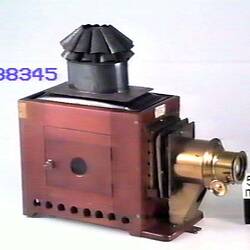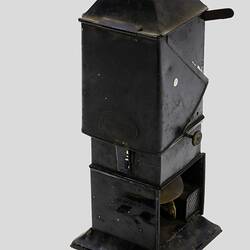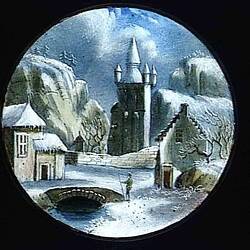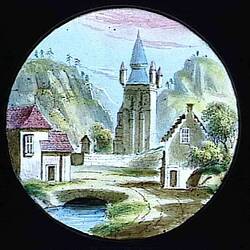Summary
Set of two projectors used in combination with shutter in magic lantern presentations.
During a show, these two projectors were angled together on a wooden support so that the images from each projector fell on the same point on a screen. This allowed for the 'dissolving' of one image into another using the fan shaped device, for example, a scene in winter (MM 31923) becomes the same but in summer (MM 31922). The fan shaped shutter (ST 38345.3) was used to achieve the dissolving effect.
The shutter was manipulated mechanically, acting like a mask to obscure the projected image from one of the lanterns as the image from the twin lantern was exposed.
Either projector could also be used alone to project a series of slides.
Specifically paired side by side lanterns allowing for 'dissolving' views are claimed to have been first manufactured by a Dublin optician named Clarke prior to 1822. Regardless, by the 1830s, the showing of dissolving images had gained great popularity.
These type of finely crafted double lanterns were manufactured from at least the 1850s and by the 1880s a large number of different models of these side by side double lanterns were being sold. The company which manufactured these particular lanterns was operational under the name Newton & Co. from 1858 and by the 1880s had become one of Britain's most important manufacturers of magic lanterns and slides. It is probable that these lanterns date from this period.
While the invention of the magic lantern is generally seen to be in the 17th century, its greatest popularity as an optical projector spans the late 18th Century to the early decades of the 20th Century. It was used both as a means of entertainment and education.
This lantern projector set is part of the Francis Collection of pre-cinematic apparatus and ephemera, acquired by the Australian and Victorian Governments in 1975. David Francis was the curator of the National Film and Sound Archive of the British Film Institute as well as being a co-founder of the Museum of the Moving Image in London, which was operational between 1988 and 1999.
Physical Description
These two lanterns are identical apart from some mirror image features. Both lanterns feature a mahogany body, with brass lens barrels, slide holders and controls. The roof and cowl are of japanned metal. Designed to be placed side-by-side, one lantern has a door to the illumination chamber on the right side of the body, the other on the left. Both doors have a circular viewing window. A brass control on the lens barrel is also placed on opposing sides. Both lanterns used ordinary household coal gas as an illuminant. The 'dissolving screen' or shutter is manufactured of brass, with a handle to allow it to be mechanically manipulated.
More Information
-
Collection Names
-
Collecting Areas
-
Acquisition Information
Loan & Subsequent Donation from Australian Film Institute (AFI), Mr David Francis, by Nov 1990
-
Manufacturer
Newton & Co., London, England, Great Britain, 1858-1899 (probably 1880s)
-
Collector
Mr David Francis, London, Middlesex, England, Great Britain, 1990
-
Inscriptions
Ivory coloured plaques on front of lanterns: 'NEWTON & CO/OPTICIANS/TO THE QUEEN/3 FLEET STREET/LONDON'
-
Classification
Communications, Audio-visual technology, Image projection equipment
-
Category
-
Discipline
-
Type of item
-
Overall Dimensions
50 cm (Length), 40 cm (Width), 20 cm (Height)
Measurements for Projector only. Measurements taken by Curator.
-
References
[Book] Robinson, David, et al. 2001. Encyclopaedia of the Magic Lantern., 2001, 94, 202, 209-10. Pages
-
Keywords







